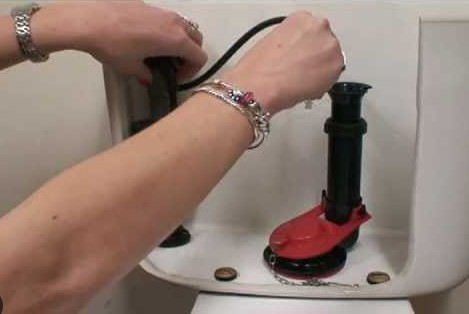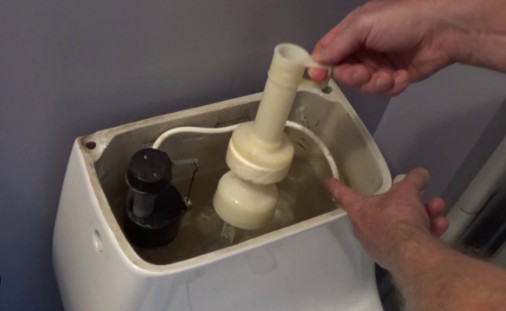When a Kohler toilet refill tube pops out, it disrupts your toilet’s normal functioning and leads to unnecessary water wastage. You are not alone if you tend to deal with this issue, but what causes this problem?
If your Kohler toilet refill tube pops out, it could be because of high water pressure, improper installation, or age and wear. Troubleshooting and fixing these causes will help you address the issue.
You can get your toilet working smoothly again by fixing this problem. This post comprehensively delves into the causes and fixes of this issue.

Kohler Toilet Refill Tube Pops Out (Problems & Fixes!)
| Problem | Possible Causes | Recommended Fixes | |
| 1. | Age and Wear | Normal usage Corrosion | Replace worn-out components Upgrade old components with modern ones Use a water softener to prevent corrosion Use mild cleaning agents |
| 2. | High Water Pressure | Install a pressure regulator Adjust the pressure regulator Don’t flush your toilet forcefully | |
| 3. | Improper Installation | Incorrect positioning Lack of secure attachment | Secure the refill tube properly with clips, clamps, or zip ties Ensure the refill tube isn’t kinked or twisted Trim the refill tube if it’s too long |
1. Age and Wear
Like any other mechanical system, Kohler toilet components undergo age and wear over time, leading to a range of issues, including the frustrating problem of the refill tube popping out. Exposure to cleaning agents, water, and the usual wear and tear of daily use cause metallic, plastic, and rubber toilet materials to degrade.
As components age, the attachment points that secure the refill tube in place can become looser. This can result in the tube popping out during flushing due to the increased movement within the toilet tank.
In addition, minerals can corrode metallic parts weakening connections and causing parts to dislodge more easily.
Fix
- Regularly inspect the refill tube, fill valve, and other components for signs of wear or damage and address any issues promptly to prevent further deterioration.
- Choose genuine replacement parts for damaged components. The Fluidmaster 218 Toilet Refill Tube and Clip Replacement (View on Amazon) is highly durable, easy to install, and compatible with a majority of fill valves.
- Consider reducing mineral deposits using a water softener if corrosion is a concern.
- Stick to non-abrasive, mild cleaning products to safeguard the components’ integrity. This helps prolong the lifespan of metal components and minimize corrosion-related issues.
- Explore the option of upgrading to more modern and durable components if your toilet is relatively old. Newer fill valves and refill tube designs offer improved functionality and longevity.
2. Improper Installation
For proper functioning, the refill tube must be positioned in a way that allows water to flow smoothly without any kinks or obstructions. An improperly installed refill tube in your Kohler toilet can lead to a myriad of inconveniences, including the tube frequently popping out during flushing.
For instance, if you don’t securely attach the refill tube to the fill valve and the overflow pipe, it can easily become dislodged when water flows through the system. Placing the refill tube in the wrong position within the toilet tank can also cause it to pop out.
Fix
- Read the installation instructions provided with your Kohler toilet for guidance on the correct steps for installing the refill tube and other components.
- Secure the refill tube to the fill valve and the overflow pipe, making sure you achieve a snug fit at both ends of the tube.
- Ensure the refill tube is not twisted or kinked.
- Secure the refill tube using clamps or clips, which you can replace if they are in poor condition. Alternatively, use zip ties.
- Trim the tube to an appropriate length if it is excessively long since it might cause too much slack, leading to issues during flushing.
3. High Water Pressure
High water pressure can stress various components within your toilet tank, causing the refill tube to dislodge during flushing. This force can make the fill tube pop out from its attachment points, disrupting the refill process.
Besides forcefully dislodging the fill tube, prolonged exposure to high water pressure can accelerate wear and tear on various parts of the toilet. This can lead to premature deterioration and malfunction.
Fixes
a) Check Water Pressure Levels
Measure the existing water pressure with a gauge. If it exceeds recommended levels (usually around 40-60 psi), it’s a sign that you may need a pressure regulator.
b) Install A Water Pressure Regulator
Attach a water pressure regulator to the water supply line leading to your toilet to regulate and reduce the incoming water pressure to a safe and manageable level, preventing excessive force within the toilet tank.
c) Adjust the Regulator
If your toilet is already equipped with a pressure regulator, ensure it is properly adjusted. Adjust the regulator’s setting to achieve the desired water pressure level.
d) Monitor Flushing
Be mindful of how you flush the toilet. Avoid forcefully pressing the flush lever because this can increase the pressure within the tank and contribute to the refill tube popping out.
e) Contact a Professional
Consult a professional plumber if you’re unsure about installing or adjusting a pressure regulator. Do so if you are also experiencing other issues related to water pressure.

How To Replace Kohler Refill Tube
Replacing a refill tube in a Kohler toilet is a relatively simple process. Here’s a guide for replacing the refill tube:
The Needed Materials
- New refill tube (often available in toilet repair kits)
- Adjustable wrench or pliers
- Bucket or towels (to catch any water)
Steps
1) Turn Off the Water Supply
You should not replace your Kohler refill tube while water still flows into your toilet, so turn the water shut-off valve clockwise. This valve is typically on the bathroom floor or wall at the toilet base.
2) Flush the Toilet
Flush the toilet to remove water from the tank to make accessing and working on the components inside the tank easier.
3) Remove the Tank Lid
Carefully lift the toilet tank lid and set it aside on a soft surface to prevent it from getting scratched or damaged.
4) Disconnect and Remove the Refill Tube
Look inside the toilet tank and locate the refill tube. It is a flexible plastic tube usually connected to the fill valve at one end and to the overflow tube or a clip on the other end.
After flushing the toilet, the fill valve refills the tank. The refill tube is often connected to a small nozzle on the fill valve.
Gently pull the refill tube off the nozzle. If a clip or plastic clamps hold the refill tube in place, release it.
After that, carefully remove the refill tube from the clip or overflow tube. If there’s a clip, gently squeeze or release the clip to free the refill tube.
The other end of the refill tube is connected to the fill valve and is usually secured into place by a plastic nut. So, loosen and unscrew the nut with an adjustable wrench or pliers, then disconnect the refill tube from the fill valve.
5) Install the New Refill Tube
Take the new refill tube and insert it into the hole on the fill valve where the old tube was connected. Secure the refill tube to the fill valve with a plastic nut, screw, or clip per the manufacturer’s instructions.
Tighten the nut with an adjustable wrench or pliers if needed. However, be careful not to overtighten.
Take the new refill tube and connect one end to the nozzle on the fill valve. If there’s a clip or clamp, secure the tube in place.
After that, guide the other end of the refill tube to the overflow tube or clip. If there’s a clip, make sure it securely holds the refill tube in place. If there’s no clip, insert the tube into the overflow tube.
Position the refill tube in a way that it won’t interfere with the flush valve or other components inside the tank. Also, trim the refill tube if it’s too long to achieve the right position.
The refill tube should direct water into the overflow tube without getting submerged in water.
6) Turn The Water Back On
Turn the valve counterclockwise to reopen the water. Water will begin to fill the tank.
7) Check for Leaks
Watch for any leaks around the connections of the refill tube. Properly tighten the links if you see any leaks.
8) Test the Toilet
Flush the toilet and let it refill. Ensure the water flows smoothly through the refill tube and into the overflow tube without any issues.
9) Replace the Tank Lid
Once everything works properly, place the toilet tank lid back onto the tank.

Why Is Water Coming Out Of The Refill Tube On A Toilet?
If water is coming out of the refill tube on a toilet, it is likely because of an issue with the float mechanism or the toilet’s fill valve. The common reasons include an incorrect float level, a faulty fill valve, misaligned or damaged components, valve obstructions, high water pressure, and flapper valve issues.
Setting the float high can lead to a water overflow into the refill tube. On the other hand, if it’s faulty, the fill valve might not shut off when the water reaches the correct level.
In addition, the valve may fail to close properly due to debris or mineral buildup, causing water to flow into the tank and down the refill tube continuously. Moreover, high water pressure causes the same issue.
The following solutions will help you address this problem.
- Ensure the float is at the correct level.
- Replace the fill valve.
- Check for any visible damage or misalignment and conduct the necessary replacements or repairs.
- Clean the current fill valve or install a new one.
- Consider fitting in a pressure regulator to address consistently high water pressure.
- Check and replace the flapper if needed.
Summary of Kohler Toilet Refill Tube Pops Out
Whether it’s a matter of proper installation, water pressure adjustment, or component replacement, taking the time to resolve this issue will ensure a more efficient and trouble-free toilet experience. So, address the underlying causes and apply the appropriate fixes to restore your toilet’s functionality and prevent further inconvenience.
Here are other interesting posts:
